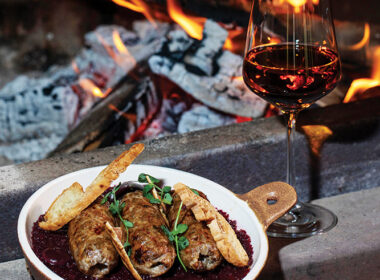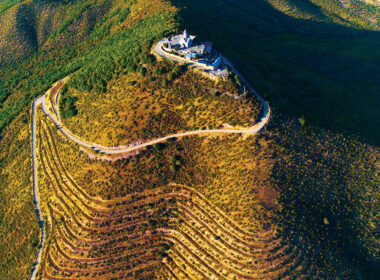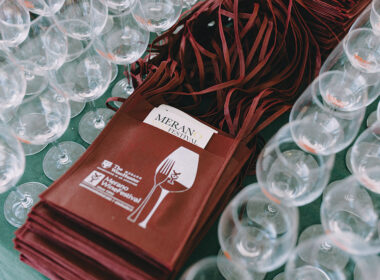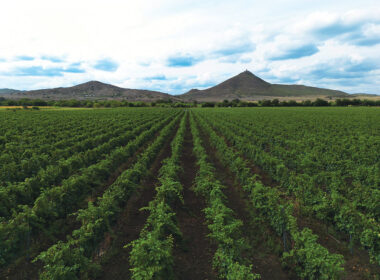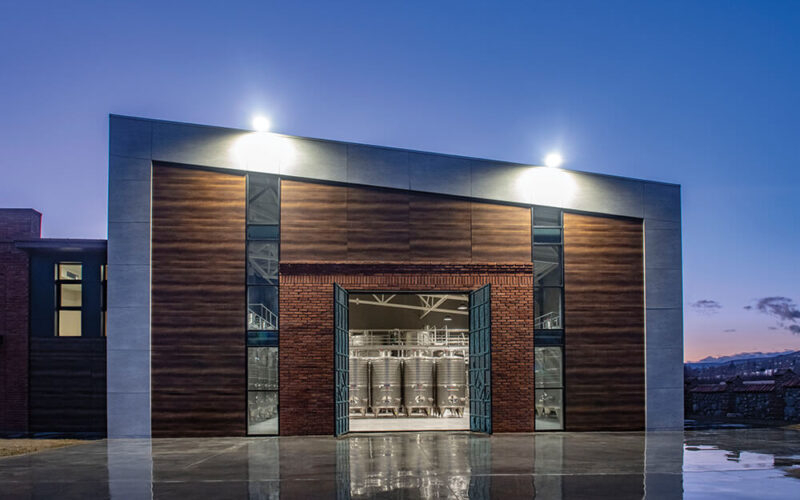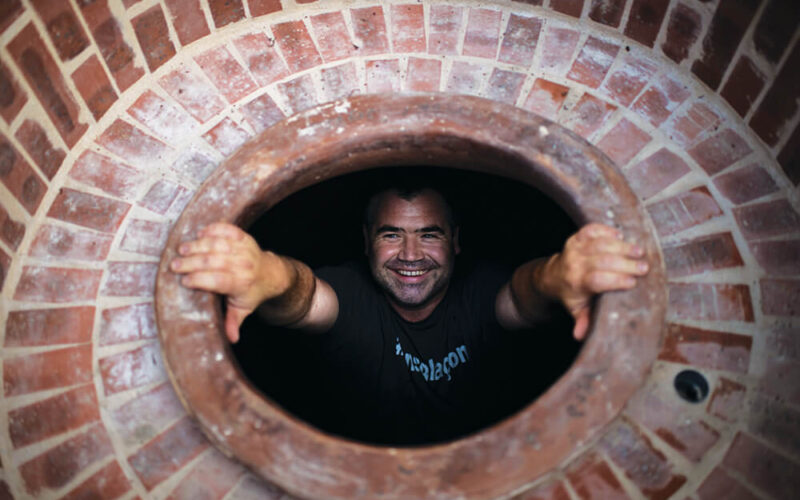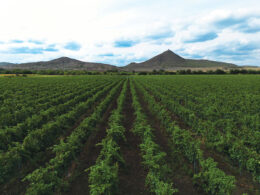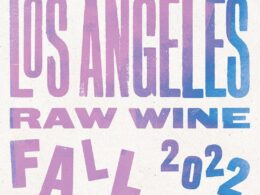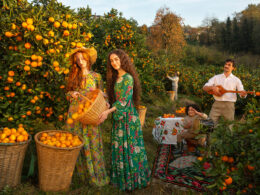| By Nana Jojishvili
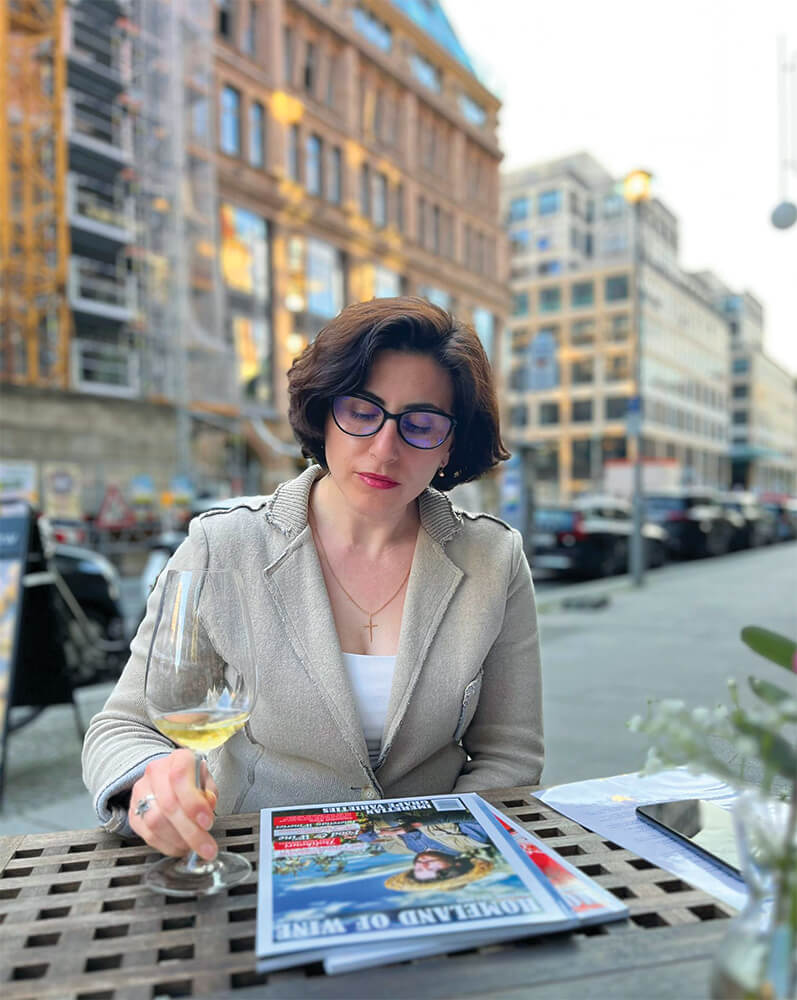
Amedee Mathier
Valais/Switzerland
The history of a family run winery, “Albert Mathier & Fils,” begins from the time of Amedee’s grandfather in 1928. The winery located in Switzerland’s wine region of Valais is surrounded with approximately
The vineyard’s acreage is nearly 50 hectares, where 37 grape varieties are planted. They sell most of the wine in Switzerland and the rest in neighbouring countries. They have made wine in Qvevri for 15 years now.
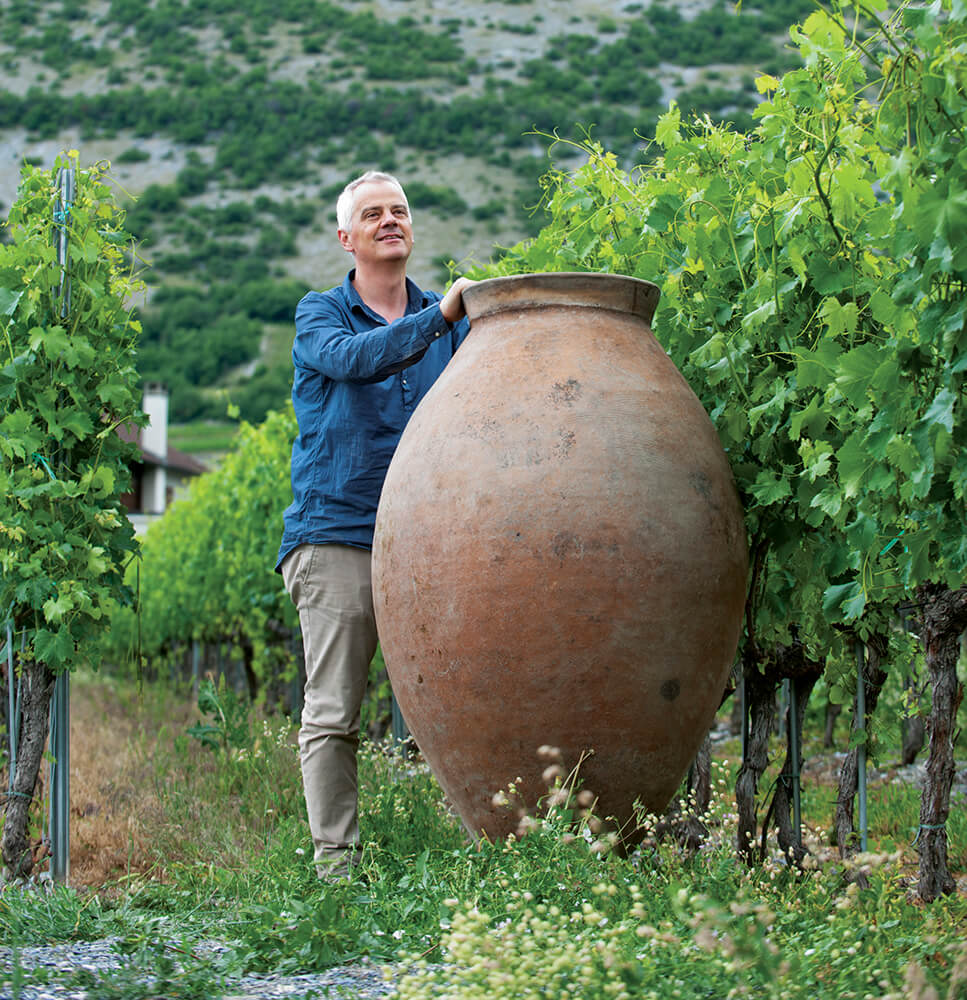
Q: Mr. Mathier, I’m glad to be meeting with you four years later. I first tasted your qvevri wine in 2018, which was notable for its elegant structure and harmony. The wine wasn’t made from Georgian varieties; nonetheless the Georgian character was still detectable, which for me made it familial, and intriguing. Could you tell me, when and where did you hear about Georgian wine first and what piqued your interest in qvevri?
A: “At the beginning of the year 2000, I was hearing a lot about Georgia as the homeland of wine. One fine evening, together with my friend, who was already well acquainted with your country, we had the idea to pay a visit, which could only come to fruition in 2008. This was a marvellous journey. My brother and I were thinking to invest in Georgia. We wanted to acquire a winery or a vineyard, but due to the 2008 Russia-Georgia war our plans failed.
During my travels, by chance, I met an elderly man. I was with the group when he, in a friendly but firm manner, asked me to accompany him to his wine cellar. He wanted to show me something. At the very end of the cellar, with small spades, we started digging the ground up. At approximately 40 cms down, a qvevri emerged in which he had made wine 14 years ago for his grandson, which in line with Georgian tradition, he was supposed to open only on his wedding day. As a mark of respect for me, he unsealed the qvevri early. In that small cellar, surrounded with tools, jars of marinades and wine casks, I happened to witness an extraordinary moment. It was very touching to see this person’s attitude towards wine, the tradition, and the guest. It was thanks to this story that I decided to bring qvevries to Switzerland and make wine in accordance with the Georgian method.”
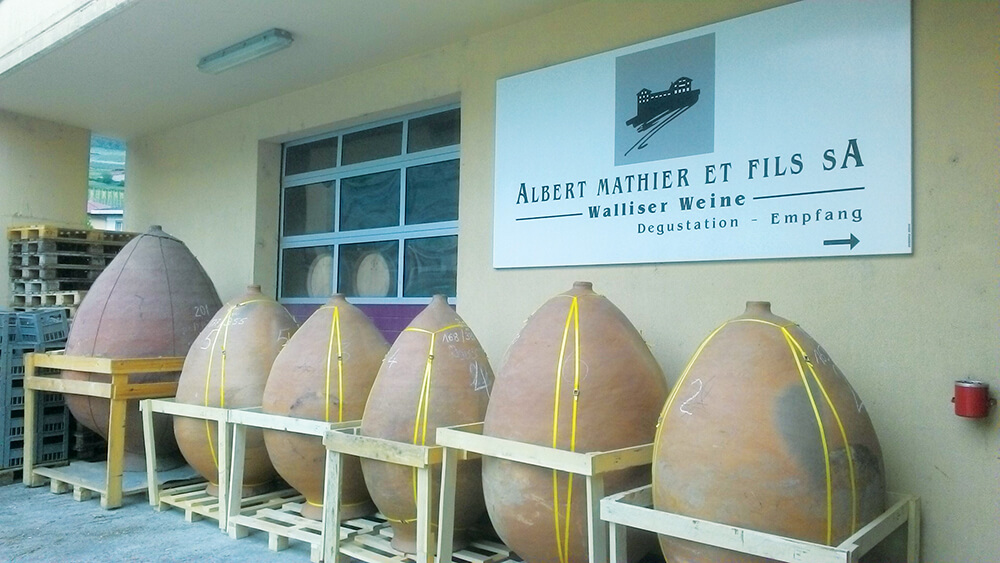
At first, he came face to face with complications in the process of “planting” qvevri. Which turned out to be a very challenging but at the same time unique experience. Due to qvevri’s large size, the ground excavation required the assistance of a construction company. Later came the main question: which grape variety to choose to make the qvevri wine? In the past, the people of Valais were hill people that would come down from the mountains to the plains, in Spring, and go back up in Autumn. Throughout the year they were occupied with farming and viticulture. In Autumn, after gathering harvests in the plains, they would go back up whilst carrying young wine, which they would be aging in wooden casks on top of glaciers, 1500m above the sea level. In the mountains, wine could maintain ideal temperature and humidity. For Gletscherwein they would use old, local white grape varieties Rezi and Ermitage. It was this very 600-year-old tradition that Amadee came to remember, which is known as Gletscherwein or Glacier wine. Since in his vineyard both varieties were available, he decided to use them for making qvevri wine.
“We lightly pressed the grapes and together with the stalks, fermented them in a qvevri. This was sort of an experiment; we had no idea whether it would be a success. The first attempt ended in failure, hence we decide to look for the solution in Georgia.
We were lucky, since in Kakheti, in their own historic cellar, Alaverdi convent monks showed us how to make qvevri wine the right way, which reminded me that my father before the 60’s was using the same method to make wine, but instead of qvevri he used concrete reservoirs in which he would leave the wine with the skins and stems for 6-8 months.
To this day, in our cellar, we have 25 qvevries, the smallest one is of a 251L capacity, the largest- 2291L. Our qvevries were made by 3 different craftsmen from Kakheti and Imereti, a few of the qvevries even have their hallmarks on them. First, we press grapes, remove the stalks, and add 40-60% of the selected stalks to the grape must. We use both white and red varieties for qvevri wine, from white – Rezi, Ermitage, Viognier and Riesling. Working with Riesling is interesting, since this variety, due to its highly acidic quality, acquires good flavour properties inside the qvevri. We make red wine primarily from Syrah and Cabernet Franc varieties. We tried to experiment as well and in 2020 we made wine from Syrah alone and left it in the qvevri for 24 months.
At first, we tried the Kakhetian method of sealing qvevries, we placed schists on top of the qvevries and covered it with soil. Nowadays we use glass discs with an airlock which allows us to control the wine inside the qvevri. At the time of racking, we use dry ice to protect the wine from oxidation; afterwards we leave some of the qvevries empty and fill the rest with sulphur water.
Our entire production of red and white qvevri wines consists of 5000 bottles. This is our signature product, the selling which is not an easy task in comparison to our classically made wines. Consumers require some time to get to know and understand the qvevri wine. We approach those who haven’t tasted it yet with great caution, by familiarising them with the history, which they find impressive.”
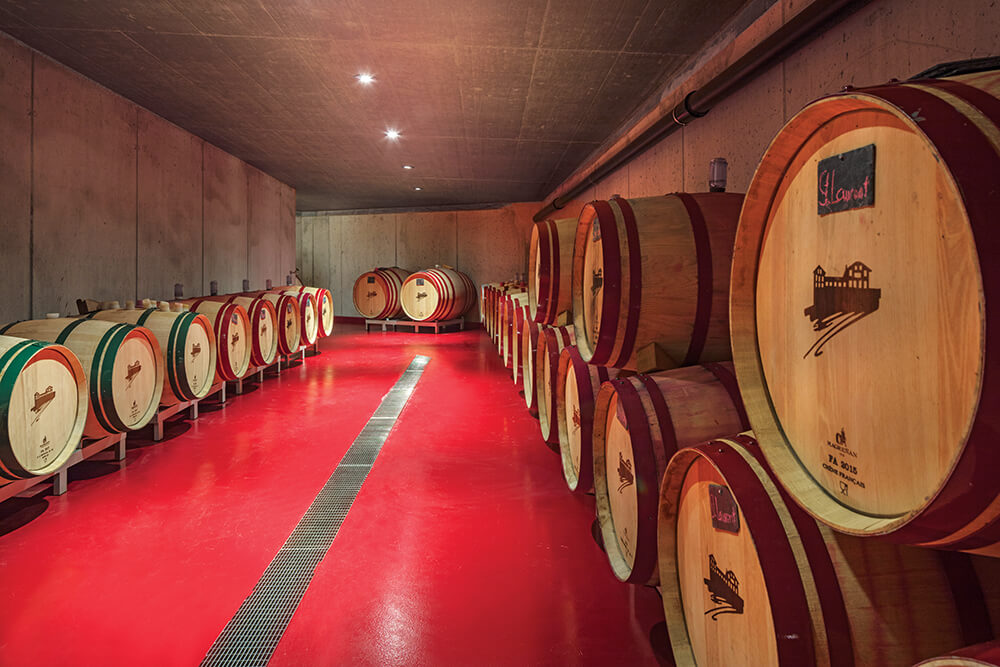
მეღვინეობა ალბერტ მათიერ & ფის.
ამადეე მათიერი. ღვინის რეგიონი: ვალე/შვეიცარია.
საოჯახო მეღვინეობა Albert Mathier & Fils ისტორია 1928 წელს, ამადეეს ბაბუის დროიდან იწყება. მეღვინეობა შვეიცარიის ღვინის რეგიონ ვალეში მდებარეობს, რომელიც დაახლოებით 200 კმ სიგრძის რონის, ვალეს და ბერნის ალპებით არის გარშემორტყმული. ვალე წარმოშობით რონის ნაწილია. ვენახის ფართობი დაახლოებით 50 ჰექტარია, სადაც 37 ყურძნის ჯიშია გაშენებული. ღვინოს ძირითადად შვეიცარიაში ყიდიან, ნაწილს – მეზობელ ქვეყნებში. ქვევრში ღვინოს კი უკვე 15 წელია აყენებენ.
Q: ბატონო მათიერ, მიხარია თქვენთან შეხვედრა 4 წლის შემდეგ. პირველად თქვენი ქვევრის ღვინო 2018 წელს გავსინჯე, რომელიც გამოირჩეოდა დახვეწილი სტრუქტურითა და ჰარმონიულობით. ღვინო ქართული ყურძნის ჯიშებისგან არ იყო დაყენებული, მაგრამ იგრძნობოდა ქართული ხასიათი, რაც ჩემთვის ღვინოს ნაცნობს, ახლობელს და საინტერესოს ხდიდა. მომიყევით, როდის და საიდან გაიგეთ პირველად ქართული ღვინის შესახებ და რატომ დაინტერესდით ქვევრით?
A: საქართველოს, როგორც ღვინის ქვეყნის შესახებ 2000 წლის დასაწყისში ბევრი მესმოდა. ერთ მშვენიერ საღამოს, ჩემს მეგობართან ერთად, რომელიც თქვენს ქვეყანას კარგად იცნობდა, ვიზიტის იდეაც გაჩნდა, რომელიც მხოლოდ 2008 წელს განხორციელდა. ეს იყო საოცარი მოგზაურობა. მე და ჩემი ძმა საქართველოში ინვესტიციის ჩადებასაც ვფიქრობდით. გვსურდა, მეღვინეობა, ან ვენახი შეგვეძინა, მაგრამ 2008 წლის რუსეთ-საქართველოს ომის გამო, ჩვენი გეგმები ვერ განხორციელდა.
მაშინდელი მოგზაურობისას შემთხვევით გავიცანი ერთი მოხუცი კაცი. ჯგუფთან ერთად ვიყავი, როდესაც მან მეგობრულად, მაგრამ მტკიცედ მთხოვა თავის მარანში გავყოლოდი, სურდა ჩემთვის რაღაც ეჩვენებინა. მარნის ბოლოში, პატარა ნიჩბებით დავიწყეთ მიწის ამოთხრა. დაახლოებით 40 სანტიმეტრის სიღრმეზე გამოჩნდა ქვევრი, რომელშიც 14 წლის წინ, თავისი შვილიშვილისთვის დაეყენებინა ღვინო და რომელიც ქართული ტრადიციის მიხედვით, მის ქორწილში უნდა გაეხსნა. ჩემს პატივსაცემად, ქვევრს დროზე ადრე მოხადა თავი. იმ პატარა მარანში, სამუშაო იარაღების, მწნილის ქილების და ღვინის ბოცების გარემოცვაში საოცარი მომენტის თანაზიარი გავხდი. ძალიან ამაღელვებელი იყო ამ ადამიანის დამოკიდებულება ღვინის, ტრადიციების, სტუმრის მიმართ. სწორედ ეს ისტორია გახდა მიზეზი, ქვევრები შვეიცარიაში წამომეღო და ქართული მეთოდით ღვინო დამეყენებინა.
ქვევრთან მუშაობისას პირველ სირთულეს ამადეე მისი დარგვის პროცესში გადააწყდა, რაც დიდი გამოწვევა და, იმავდროულად, მნიშვნელოვანი გამოცდილება აღმოჩნდა. ქვევრის სიდიდის გამო, მიწის ამოსათხრელად სამშენებლო კომპანიის მანქანის დახმარება გახდა საჭირო. შემდეგ გაჩნდა მთავარი კითხვა: რომელი ყურძნის ჯიშისგან უნდა დაემზადებინა ქვევრის ღვინო? წარსულში, ვალეს ხალხი მომთაბარეები იყვნენ, რომლებიც გაზაფხულზე მთიდან ბარში ჩამოდიოდნენ, შემოდგომით კი უკან ბრუნდებოდნენ. წელიწადის ყველა დროს მევენახეობითა და მესაქონლეობით იყვნენ დაკავებულები. შემოდგომაზე, როდესაც ბარში მოსავალს აიღებდნენ, მთაში მიდიოდნენ და თან ახალგაზრდა ღვინო მიჰქონდათ, რომელსაც ხის კასრებში ზღვის დონიდან 1500 მეტრ სიმაღლეზე, მყინვარზე ავარგებდნენ. მთაში ღვინო იდეალურ ტემპერატურას და ტენიანობას ინარჩუნებდა. Gletscherwein-სთვის იყენებდნენ ძველ, თეთრ ადგილობრივ ყურძენი ჯიშებს რეცის (Rezi) და ერმიტაჟს (Ermitage). ამადეემ სწორედ ეს 600-წლიანი ტრადიცია გაიხსენა, რომელსაც გლეტჩერვაინი (Gletscherwein) ანუ მყინვარის ღვინო ეწოდება. რადგან ვენახში ორივე ყურძნის ჯიში ჰქონდა გაშენებული, გადაწყვიტა სწორედ ისინი გამოეყენებინა ქვევრის ღვინის დასაყენებლად.
„ყურძენი მსუბუქად დავჭყლიტეთ და კლერტთან ერთად ქვევრში დავადუღეთ. ეს ერთგვარი ექსპერიმენტი იყო, რომელიც არ ვიცოდით, რამდენად გაამართლებდა.
პირველი ცდა წარუმატებელი აღმოჩნდა, რის შემდეგაც გამოსავალის ძებნა საქართველოში დავიწყეთ. ძალიან გაგვიმართლა, რადგან კახეთში, ალავერდის მონასტრის ბერებმა მათსავე ისტორიულ მარანში მაჩვენეს, როგორ უნდა დამეყენებინა სწორად ქვევრის ღვინო. ნანახმა გამახსენა, რომ მამაჩემი 60-იან წლებამდე ასეთივე მეთოდით აყენებდა ღვინოს, ოღონდ ქვევრის ნაცვლად ბეტონის რეზერვუარებს იყენებდა, სადაც ღვინოს 6-8 თვე ჭაჭა-კლერტზე ტოვებდა.
დღეს, მარანში სხვადასხვა ტევადობის 25 ქვევრი გვაქვს. ყველაზე პატარა 251 ლიტრის ტევადობისაა, ყველაზე დიდი კი – 2 291 ლიტრის. ჩვენი ქვევრები სამი ოსტატის მიერ არის დამზადებული კახეთიდან და იმერეთიდან. რამოდენიმე ქვევრს ოსტატის დამღა აქვს. ყურძენს ჯერ ვწურავთ, ვაცლით კლერტს და გადარჩეული კლერტის 40-60% ვამატებთ დურდოს. ქვევრის ღვინისთვის როგორც წითელ, ისე თეთრ ჯიშებს ვიყენებთ. თეთრებიდან რეცეს, ერმიტაჟს, ვიოგნერს და რისლინგს. რისლინგთან მუშაობა საინტერესოა, რადგან ეს ჯიში მისთვის დამახასიათებელი მაღალი მჟავიანობის გამო ქვევრის ღვინოში კარგ გემოვნურ თვისებებს იძენს. წითელ ღვინოს კი ძირითადად სირას და კაბერნე ფრანის ჯიშებისგან ვაყენებთ. ვცადეთ ექსპერიმენტიც – 2020 წელს სირა ცალკე დავაყენეთ და 24 თვის განმავლობაში ქვევრში დავტოვეთ.
ქვევრის დალუქვისას თავდაპირველად კახური მეთოდს მივმართეთ, ქვევრებს სიპის ქვა დავადეთ და მიწით დავფარეთ. დღეს უკვე შუშის სახურავებს ვიყენებთ, რომელსაც ზემოდან საჰაერო სარქველი აქვს, რაც ქვევრში ღვინის გაკონტროლების საშუალებას გვაძლევს. გადაღების დროს ვიყენებთ მშრალ ყინულს, რომელიც ღვინოს დაჟანგვისგან იცავს; შემდეგ კი ქვევრების ერთ ნაწილს მშრალად ვტოვებთ, ნაწილს კი გოგირდიანი წყლით ვავსებთ.
ჩვენ მიერ ქვევრის თეთრი და წითელი ღვინის მთლიანი წარმოება 5 000 ბოთლს შეადგენს. ეს ნიშური პროდუქტია, რომლის გაყიდვაც, განსხვავებით კლასიკურად დაყენებული ღვინისგან, არ არის ადვილი. ქვევრის ღვინის გასაგებად და შესაცნობად მომხმარებელს სჭირდება დრო. მათ, ვისაც ის ჯერ არ გაუსინჯავს, დიდი სიფრთხილით ვასინჯებთ, ვუყვებით და ვაცნობთ ისტორიას, რომლითაც მომხმარებელი აუცილებლად აღფრთოვანდება.”

